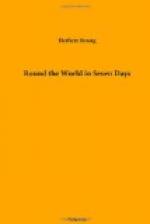The man proved to be the chauffeur of the aeroplane; his employer was drowned. Smith lost the race, but he gained what was infinitely more valuable to him, the gratitude and devotion of Laurent Rodier. Finding that the Frenchman was an expert mechanician, Smith took him into his employment. Rodier turned out to be of a singularly inventive turn of mind, and the two, putting their heads together, evolved after long experiment a type of engine that enabled them to double the speed of the aeroplane. These aerial vessels had already attained a maximum of a hundred miles an hour, for progress had been rapid since Paulhan’s epoch-making flight from London to Manchester. To the younger generation the aeroplane was becoming what the motor-car had been to their elders. It was now a handier, more compact, and more easily managed machine than the earlier types, and the risk of breakdown was no greater than in the motor-car of the roads. The engine seldom failed, as it was wont to do in the first years of aviation. The principal danger that airmen had to fear was disaster from strong squalls, or from vertical or spiral currents of air due to some peculiarity in the confirmation of the land beneath them.
Smith’s engine was a compound turbine, reciprocating engines having proved extravagant in fuel. There were both a high and a low pressure turbine on the same shaft, which also drove the dynamo for the searchlight and the lamp illuminating the compass, and for igniting the explosive mixture. By means of an eccentric, moreover, the shaft worked a pump for compressing the mixture of hot air and petrol before ignition, the air being heated by passing through jackets round the high-pressure turbines. The framework of the planes consisted of hollow rods made of an aluminum alloy of high tensile strength, and the canvas stretched over the frames was laced with wire of the same material. To stiffen the planes, a bracket was clamped at the axis, and thin wire stays were strung top and bottom, as the masts of a yacht are supported. The airman was in some degree protected from the wind by a strong talc screen, also wire-laced; by means of this, and a light radiator worked by a number of accumulators, he was enabled to resist the cold, which had been so great a drawback to the pioneers of airmanship.
In this aeroplane Smith and Rodier had made many a long expedition. They had found that the machine was capable of supporting a total weight of nearly 1,200 lbs., and since Smith turned the scale at eleven stone eight, and Rodier at ten stone, in their clothes, the total additional load they could carry was about 900 lbs. Eighty gallons of petrol weighed about 600 lbs. with the cans, and twenty gallons of lubricating oil about 160 lbs., so that there was a margin of nearly 150 lbs. for food, rifles, and anything else there might be occasion for carrying at any stage of the journey.




